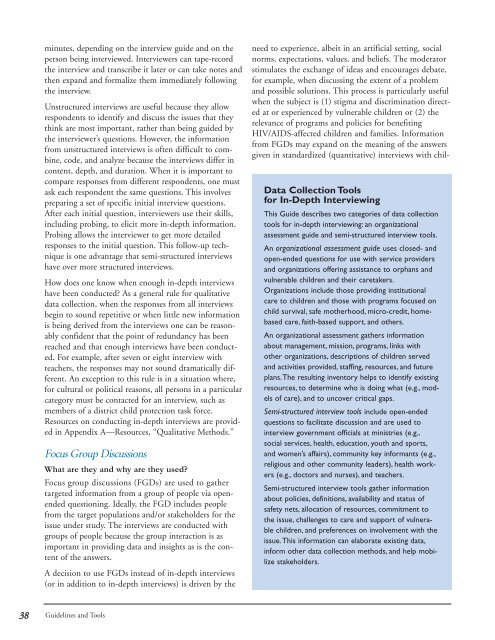Conducting a Participatory Situation Analysis of.pdf - Global HIV ...
Conducting a Participatory Situation Analysis of.pdf - Global HIV ...
Conducting a Participatory Situation Analysis of.pdf - Global HIV ...
Create successful ePaper yourself
Turn your PDF publications into a flip-book with our unique Google optimized e-Paper software.
minutes, depending on the interview guide and on the<br />
person being interviewed. Interviewers can tape-record<br />
the interview and transcribe it later or can take notes and<br />
then expand and formalize them immediately following<br />
the interview.<br />
Unstructured interviews are useful because they allow<br />
respondents to identify and discuss the issues that they<br />
think are most important, rather than being guided by<br />
the interviewer’s questions. However, the information<br />
from unstructured interviews is <strong>of</strong>ten difficult to combine,<br />
code, and analyze because the interviews differ in<br />
content, depth, and duration. When it is important to<br />
compare responses from different respondents, one must<br />
ask each respondent the same questions. This involves<br />
preparing a set <strong>of</strong> specific initial interview questions.<br />
After each initial question, interviewers use their skills,<br />
including probing, to elicit more in-depth information.<br />
Probing allows the interviewer to get more detailed<br />
responses to the initial question. This follow-up technique<br />
is one advantage that semi-structured interviews<br />
have over more structured interviews.<br />
How does one know when enough in-depth interviews<br />
have been conducted? As a general rule for qualitative<br />
data collection, when the responses from all interviews<br />
begin to sound repetitive or when little new information<br />
is being derived from the interviews one can be reasonably<br />
confident that the point <strong>of</strong> redundancy has been<br />
reached and that enough interviews have been conducted.<br />
For example, after seven or eight interview with<br />
teachers, the responses may not sound dramatically different.<br />
An exception to this rule is in a situation where,<br />
for cultural or political reasons, all persons in a particular<br />
category must be contacted for an interview, such as<br />
members <strong>of</strong> a district child protection task force.<br />
Resources on conducting in-depth interviews are provided<br />
in Appendix A—Resources, “Qualitative Methods.”<br />
Focus Group Discussions<br />
What are they and why are they used?<br />
Focus group discussions (FGDs) are used to gather<br />
targeted information from a group <strong>of</strong> people via openended<br />
questioning. Ideally, the FGD includes people<br />
from the target populations and/or stakeholders for the<br />
issue under study. The interviews are conducted with<br />
groups <strong>of</strong> people because the group interaction is as<br />
important in providing data and insights as is the content<br />
<strong>of</strong> the answers.<br />
A decision to use FGDs instead <strong>of</strong> in-depth interviews<br />
(or in addition to in-depth interviews) is driven by the<br />
need to experience, albeit in an artificial setting, social<br />
norms, expectations, values, and beliefs. The moderator<br />
stimulates the exchange <strong>of</strong> ideas and encourages debate,<br />
for example, when discussing the extent <strong>of</strong> a problem<br />
and possible solutions. This process is particularly useful<br />
when the subject is (1) stigma and discrimination directed<br />
at or experienced by vulnerable children or (2) the<br />
relevance <strong>of</strong> programs and policies for benefiting<br />
<strong>HIV</strong>/AIDS-affected children and families. Information<br />
from FGDs may expand on the meaning <strong>of</strong> the answers<br />
given in standardized (quantitative) interviews with chil-<br />
Data Collection Tools<br />
for In-Depth Interviewing<br />
This Guide describes two categories <strong>of</strong> data collection<br />
tools for in-depth interviewing: an organizational<br />
assessment guide and semi-structured interview tools.<br />
An organizational assessment guide uses closed- and<br />
open-ended questions for use with service providers<br />
and organizations <strong>of</strong>fering assistance to orphans and<br />
vulnerable children and their caretakers.<br />
Organizations include those providing institutional<br />
care to children and those with programs focused on<br />
child survival, safe motherhood, micro-credit, homebased<br />
care, faith-based support, and others.<br />
An organizational assessment gathers information<br />
about management, mission, programs, links with<br />
other organizations, descriptions <strong>of</strong> children served<br />
and activities provided, staffing, resources, and future<br />
plans.The resulting inventory helps to identify existing<br />
resources, to determine who is doing what (e.g., models<br />
<strong>of</strong> care), and to uncover critical gaps.<br />
Semi-structured interview tools include open-ended<br />
questions to facilitate discussion and are used to<br />
interview government <strong>of</strong>ficials at ministries (e.g.,<br />
social services, health, education, youth and sports,<br />
and women’s affairs), community key informants (e.g.,<br />
religious and other community leaders), health workers<br />
(e.g., doctors and nurses), and teachers.<br />
Semi-structured interview tools gather information<br />
about policies, definitions, availability and status <strong>of</strong><br />
safety nets, allocation <strong>of</strong> resources, commitment to<br />
the issue, challenges to care and support <strong>of</strong> vulnerable<br />
children, and preferences on involvement with the<br />
issue.This information can elaborate existing data,<br />
inform other data collection methods, and help mobilize<br />
stakeholders.<br />
38<br />
Guidelines and Tools















